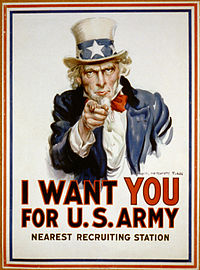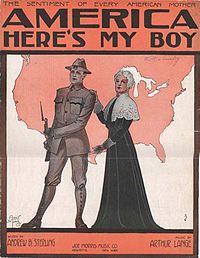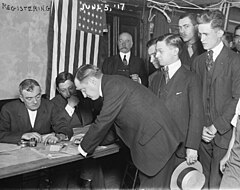
Conscription is the state-mandated enlistment of people in a national service, mainly a military service. Conscription dates back to antiquity and it continues in some countries to the present day under various names. The modern system of near-universal national conscription for young men dates to the French Revolution in the 1790s, where it became the basis of a very large and powerful military. Most European nations later copied the system in peacetime, so that men at a certain age would serve 1–8 years on active duty and then transfer to the reserve force.

A conscientious objector is an "individual who has claimed the right to refuse to perform military service" on the grounds of freedom of conscience or religion. The term has also been extended to objecting to working for the military–industrial complex due to a crisis of conscience. In some countries, conscientious objectors are assigned to an alternative civilian service as a substitute for conscription or military service.

The Selective Service System (SSS) is an independent agency of the United States government that maintains information on U.S. citizens and other U.S. residents potentially subject to military conscription and carries out contingency planning and preparations for two types of draft: a general draft based on registration lists of men aged 18–25, and a special-skills draft based on professional licensing lists of workers in specified health care occupations. In the event of either type of draft, the Selective Service System would send out induction notices, adjudicate claims for deferments or exemptions, and assign draftees classified as conscientious objectors to alternative service work. All U.S. citizens assigned male at birth and immigrant non-citizens who are between the ages of 18 and 25 are required by law to have registered within 30 days of their 18th birthdays, and must notify the Selective Service within ten days of any changes to any of the information they provided on their registration cards, such as a change of address. The Selective Service System is a contingency mechanism for the possibility that conscription becomes necessary.
The Preparedness Movement was a campaign led by former Chief of Staff of the U.S. Army, Leonard Wood, and former President Theodore Roosevelt to strengthen the U.S. military after the outbreak of World War I. Wood advocated a summer training school for reserve officers to be held in Plattsburgh, New York.

A conscription crisis is a public dispute about a policy of conscription, or mandatory service in the military, known in US English as a "draft". A dispute can become a crisis when submission to military service becomes highly controversial and popular revolt ensues. From the point of view of military officials, the crisis is one of supply; where they may claim to lack enough troops to accomplish a military objective, and have, to some degree, lost control of their political ability to enforce existing conscription law.
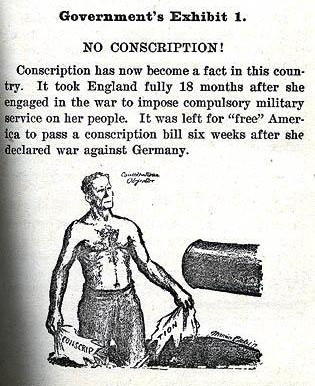
The No Conscription League was an anarchist organisation designed to promote anti-draft manifestos and aid those who refused military service. The league lasted for six weeks and was used to charge its founders Emma Goldman and Alexander Berkman with conspiracy to obstruct the draft.

Military service is service by an individual or group in an army or other militia, air forces, and naval forces, whether as a chosen job (volunteer) or as a result of an involuntary draft (conscription).

In the United States of America, military conscription, commonly known as the draft, has been employed by the U.S. federal government in six conflicts: the American Revolutionary War, the American Civil War, World War I, World War II, the Korean War, and the Vietnam War. The fourth incarnation of the draft came into being in 1940, through the Selective Training and Service Act; this was the country's first peacetime draft. From 1940 until 1973, during both peacetime and periods of conflict, men were drafted to fill vacancies in the U.S. Armed Forces that could not be filled through voluntary means. Active conscription in the United States ended in 1973, when the U.S. Armed Forces moved to an all-volunteer military. However, conscription remains in place on a contingency basis; all male U.S. citizens, regardless of where they live, and male immigrants, whether documented or undocumented, residing within the United States, who are 18 through 25 are required to register with the Selective Service System. United States federal law also continues to provide for the compulsory conscription of men between the ages of 17 and 44 who are, or who have made a declaration of intention to become, U.S. citizens, and additionally certain women, for militia service pursuant to Article I, Section 8 of the United States Constitution and 10 U.S. Code § 246.

The Committee on Public Information (1917–1919), also known as the CPI or the Creel Committee, was an independent agency of the government of the United States under the Wilson administration created to influence public opinion to support the US in World War I, in particular, the US home front.

Opposition to World War I was widespread during the conflict and included socialists, anarchists, syndicalists and Marxists as well as Christian pacifists, anti-colonial nationalists, feminists, intellectuals, and the working class.

The Selective Training and Service Act of 1940, also known as the Burke–Wadsworth Act, Pub. L.Tooltip Public Law 76–783, 54 Stat. 885, enacted September 16, 1940, was the first peacetime conscription in United States history. This Selective Service Act required that men who had reached their 21st birthday but had not yet reached their 36th birthday register with local draft boards. Later, when the U.S. entered World War II, all men from their 18th birthday until the day before their 45th birthday were made subject to military service, and all men from their 18th birthday until the day before their 65th birthday were required to register.

The Enrollment Act of 1863 also known as the Civil War Military Draft Act, was an Act passed by the United States Congress during the American Civil War to provide fresh manpower for the Union Army. The Act was the first genuine national conscription law. The law required the enrollment of every male citizen and those immigrants (aliens) who had filed for citizenship, between 20 and 45 years of age, unless exempted by the Act. The Act replaced the Militia Act of 1862.
National service in the United States has a long tradition, extending to the founding of the country. National service takes multiple forms in the U.S., including community service, military service, and other forms.
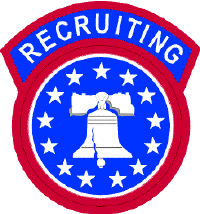
The United States Army Recruiting Command (USAREC) is responsible for manning both the United States Army and the Army Reserve. Recruiting operations are conducted throughout the United States, U.S. territories, and at U.S. military facilities in Europe, Asia, and the Middle East. This process includes the recruiting, medical and psychological examination, induction, and administrative processing of potential service personnel.
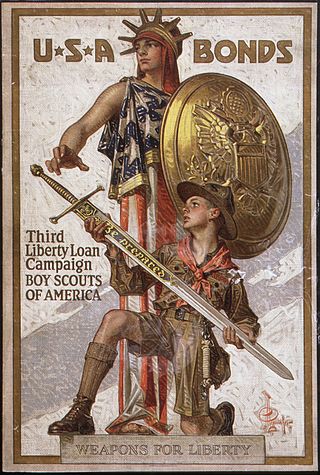
During World War I, the United States saw a systematic mobilization of the country's entire population and economy to produce the soldiers, food supplies, ammunitions and money necessary to win the war. Although the United States entered the war in April 1917, there had been very little planning, or even recognition of the problems that Great Britain and the other Allies had to solve on their own home fronts. As a result, the level of confusion was high in the first 12 months.

The United States entered into World War I in April 1917, more than two and a half years after the war began in Europe.

The United States declared war on the German Empire on April 6, 1917, nearly three years after World War I started. A ceasefire and armistice were declared on November 11, 1918. Before entering the war, the U.S. had remained neutral, though it had been an important supplier to the United Kingdom, France, and the other powers of the Allies of World War I.
United States Volunteers also known as U.S. Volunteers, U.S. Volunteer Army, or other variations of these, were military volunteers called upon during wartime to assist the United States Army but who were separate from both the Regular Army and the militia.

Edward Augustus Fitzpatrick was an American college administrator, author, editor, government official, military officer, and conscription expert. From 1929 to 1954, he served as president of Mount Mary College in Milwaukee, Wisconsin. He was known for being one of the country's foremost experts on military draft policy during World War I and World War II.

The Confederate Conscription Acts, 1862 to 1864, were a series of measures taken by the Confederate government to procure the manpower needed to fight the American Civil War.

